The Best Simpsons Episodes of the ’90s
The '90s are widely regarded as The Simpsons best era. But what's the best of the best? We find out.

The ‘90s were the decade of The Simpsons, sorry Seinfeld. The family was introduced in 1987 through a series of short clips in between skits on Fox’s The Tracey Ullman Show, overstayed their welcome and were spun off. The series debuted on Dec. 17, 1989 with a holiday special, “Simpsons Roasting on An Open Fire,” before hopping on the rotisserie of regular rotation on Jan. 14, 1990 with “Bart the Genius,” directed by David Silverman, and written by Jon Vitti.
The half-hour animated series was created by Matt Groening, who came up with it as a last-second pitch to foil his own plan to animate his comic strip Life in Hell. The Simpsons was produced by TV legend James L. Brooks, who drove The Mary Tyler Moore Show and Taxi, and Sam Simon, who wrote for Taxi and Cheers.
The voice talent continued over from the shorts. Dan Castellaneta performed the voices of Homer Simpson, his father Abe, and Krusty the Clown. Julie Kavner played Marge, as well as her sisters, Patty and Selma Bouvier, and mother Jacqueline. Nancy Cartwright voiced Bart, and Yeardley Smith performed the voice of Lisa. As a rule, the infant Maggie never speaks, but on those few occasions she did, she was voiced by Hollywood Legend Liz Taylor. Harry Shearer played several Springfield notables, such as C. Montgomery Burns, Waylon Smithers, and Seymour Skinner. Hank Azaria took on voices like Chief Wiggum and Moe.
The early episodes are crude, and it’s not just the animation. You could still hear the Walter Matthau inflection Castellaneta was putting in his Homer voice. Smithers was mistakenly rendered as Black with blue hair in early appearances. The show found its rhythm during seasons 3 and 4, which began what is known as the “Golden Era,” maybe because of the characters’ yellow skin. A storm of classics showered down from the comedy writing dream team: Simon and original showrunners Al Jean, Mike Reiss, and David Mirkin, along with Vitti, John Swartzwelder, George Meyer, Bill Oakley, Josh Weinstein, Jeff Martin, Greg Daniels, and Conan O’Brien, who really is, even now, the true Bart Simpson.
Like the earliest animated films, from Betty Boop to the first Looney Tunes shorts, The Simpsons was also aimed more squarely at adults than kids. They were not The Flintstones. This got the attention of The White House, which had also tripped over Murphy Brown’s independent journalistic approach to comedy. The 1990s became “The Simpsons Decade” when President George H.W. Bush said Americans should be “more like the Waltons and less like the Simpsons” in a major address to the country. As a former president, Bush would move across the street from the Simpson family’s Evergreen Terrace home in season 7’s “Two Bad Neighbors,” a memorable episode which didn’t make the list.
A lot of episodes don’t make this list which fans will scream at me for forgetting. I’m not forgetting, I cringe openly at some episodes which have to be left off. Three Beatles appeared in the first decade of The Simpsons: Ringo Starr in “Brush with Greatness,” George Harrison in “Homer’s Barbershop Quartet,” and Paul and Linda McCartney in “Lisa the Vegetarian.” Lisa remained a devout vegetarian throughout the remainder of the series after that appearance. Michael Jackson voiced a mental patient under a pseudonym, as Dustin Hoffman did as a substitute teacher. Country legend Johnny Cash was rendered as a cool coyote vision brought on by a hotly peppered chili.
Each and every one are classics, and leaving them off are heartbreakingly criminal acts. But, as Mr. Burns says, “If it’s a crime to love one’s country, then I’m guilty. And if it’s a crime to steal a trillion dollars from our government and hand it over to communist Cuba, then I’m guilty of that too. And if it’s a crime to bribe a jury, then so help me, I’ll soon be guilty of that!”
Excluding “Treehouse of Horror” installments and Christmas shows, here are ten episodes which work on as many levels as a football in the groin.

10. Last Exit to Springfield
Season 4 Episode 17 – March 11, 1993
Written by Jay Kogen and Wallace Wolodarsky. Directed by Mark Kirkland.
“So we’ll march through the night by the big cooling tower, they have the plant, but we have the power,” Lisa sings during the labor protest against Mr. Burns’ Nuclear Plant in “Last Exit to Springfield.” The episode captures all the promise of the subversively satirical look at life in America, sprinkling cutting commentary with the silliest of antics, and dipping into all manner of topical, cultural and Seussical references to bring the message home.
The town of Springfield’s biggest employer pays the legally lowest wages, and as Mr. Burns listens to the growing vocal accompaniment to Lisa’s song, he turns into the worst kind of Grinch. Cynical and nuanced, “Last Exit to Springfield” opens with one of the best McBain insertions, which causes Homer to tell Bart, there is no one that evil in real life. Cut to Mr. Burns, waiting for the leader of the Springfield chapter of the “International Brotherhood of Jazz Dancers, Pastry Chefs and Nuclear Technicians” trade union, who has mysteriously disappeared.
Mr. Burns was born to this. A flashback reveals he is firmly heeding his father’s earliest lessons in labor relations: “You can’t treat working men this way,” a protester yells as he is being dragged away from the turn-of-the-century plant. “One day we’ll form a union and get the fair and equitable treatment we deserve! Then we’ll go too far and get corrupt and shiftless and the Japanese will eat us alive!”
Bart writes “MUD IS NOT ONE OF THE 4 FOOD GROUPS” on the blackboard to start the episode, but even wet dirt will be hard for his sister to chew in her future. “Last Exit to Springfield” begins when Mr. Burns cancels the dental plan, and Lisa needs braces. The monstrous contraption from Painless Dentistry is an oral torture device. Homer may not be able to discern a bribe from a flirt, but he knows how to turn his personal issues into grand statements. He becomes a truly charismatic union leader. He rallies the workers to strike, and commits to the fight, even if by accident, and all while totally in over his head.
The labor negotiation scenes display inadvertent genius, but by the time Burns realizes his opponent is “not the brilliant tactician I thought he was,” it is too late. Homer not only wins the dental plan, but on the condition he steps down as union president. Woo-hoo!!
The episode is poignant and moves with an expert rhythm, infusing musical interludes like Burns and Smithers’ dance through running the plant by themselves, until they replace themselves with killer robot workers. Lisa’s dental trip is no less imaginative, gliding through her own private Pepperland in a Yellow Submarine, even her friends, The Beatles, are aboard.
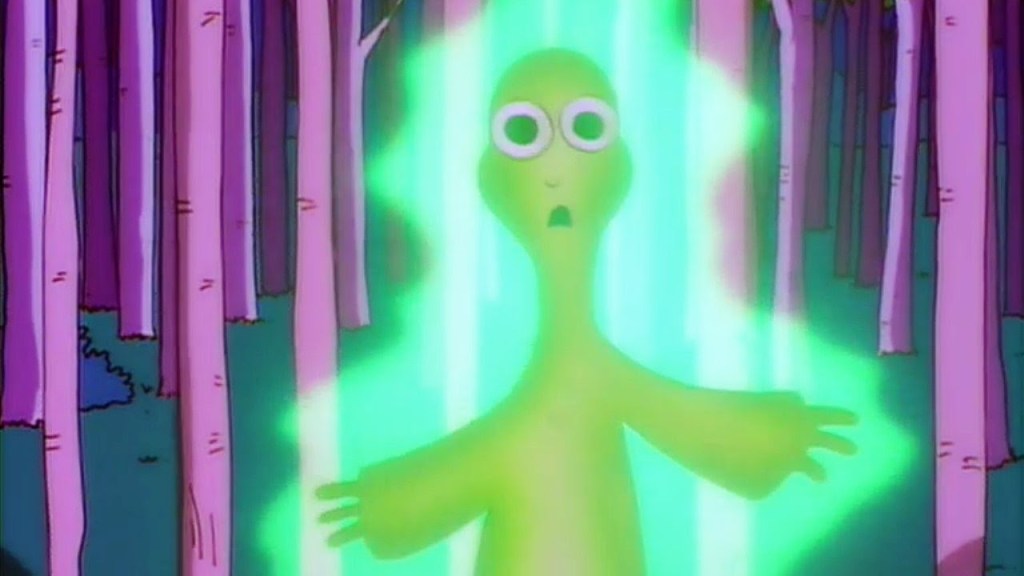
9. The Springfield Files
Season 8 Episode 10 – Jan. 12, 1997
Written by Reid Harrison. Directed by Steven Dean Moore.
“The Springfield Files” aired when The X-Files was in the middle of its fourth season, a peak for the show. The Simpsons also hit a high-water mark during season 4, which is disproportionately well-represented on this list. Coincidence, or just an excuse to replace yet another fourth season classic? “THE TRUTH IS NOT OUT THERE,” Bart writes on the blackboard.
“Are we alone in the universe? Impossible. When you consider the wonders that exist all around us: voodoo priests of Haiti, the Tibetan numerologists of Appalachia, the unsolved mysteries of Unsolved Mysteries.” So ponders Agent Fox Mulder, voiced by David Duchovny, who along with Gillian Anderson’s Agent Dana Scully, bring the cult FBI unit to Springfield on a vague rumor.
“There has been another unsubstantiated UFO sighting in the heartland of America. We’ve got to get there right away,” Fox says excitedly as the news rolls in. “There’s also this report of a shipment of drugs and illegal weapons coming into New Jersey tonight,” Scully counters. “I hardly think the FBI is concerned with matters like that,” Fox concludes, and “The Springfield Files” are added to the caseload.
The episode is introduced by Leonard Nimoy, bringing all his In Search Of… gravitas and suspense, and quickly gets lost in space. The plot is so strong you hardly feel the pain of obvious Fox hit-show crossover manipulation, more powerful than the chemical cocktail which keeps Mr. Burns alive and glowing like an alien in a field. The supernatural premise also lends itself to sublime non-sequitur cutaway riffs, and random gags to fill every frame with an otherworldly feel, and ungodly laughs.
“The Springfield Files” is a highlight for fans of The Simpsons and The X-Files alike, falling perfectly within the parameters of both shows. Mulder and Scully do not overwhelm the narrative. Moe smuggles a killer whale from SeaWorld into the plot, Hans Moleman meets several demises, and watching a shirtless Homer run on a treadmill is as hypnotic as watching a lava lamp. All the better to distract from the “Good Morning Starshine” ending singalong.
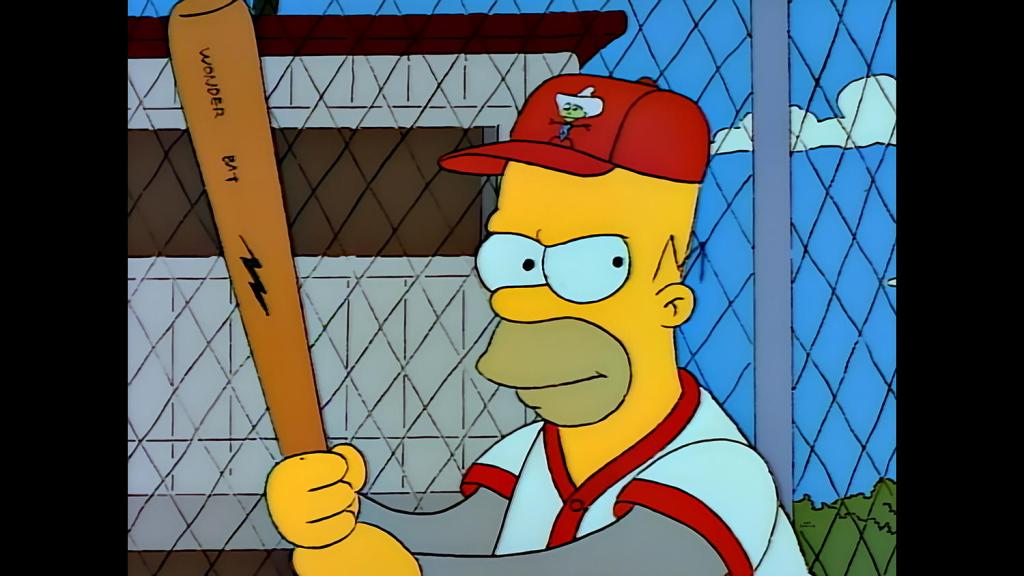
8. Homer at the Bat
Season 3 Episode 17 – Feb. 20, 1992
Written by John Swartzwelder. Directed by Jim Reardon
“Homer At the Bat” took The Simpsons out of the nightmare of dead-end blue-collar America, and into a field of dreams. The Springfield Nuclear Power Plant softball team is having a great season with a real shot at the championship game. Mr. Burns is so proud of his winning team he places a huge wager on them, and replaces the players with nine major league ringers to hedge that bet. Team leader Homer’s “secret weapon,” a tree struck by lightning which he shaves into a “Wonderbat” being no guarantee, in spite of its early promise to lead the roster through a parody of Barry Levinson’s The Natural.
Waylon Smithers is given 24 hours to assemble the perfect team. He wrangles Roger Clemens, Wade Boggs, Ken Griffey, Jr., Steve Sax, Ozzie Smith, José Canseco, Don Mattingly, and Darryl Strawberry. After being drafted for the team, Mike Scioscia decides he’d rather take a position in a hydroelectric plant. The other players also find themselves drawn into Springfield’s mutated reality. Smith is sucked into a wormhole just touring local caves, while Griffey Jr. contacts gigantism from nerve gas exposure.
Soon, Sax joins a local jazz combo, ultimately getting arrested on suspicion of being responsible for all unsolved crimes in New York. Barney knocks Boggs unconscious in a bar fight over Britain’s greatest Prime Minister. Canseco is a hero off the field, saving pets, books, and even furniture from a burning house before collapsing from smoke inhalation. Burns doesn’t approve of Mattingly’s egregious sideburns, and a hypnotized Clemens is too chicken to come out of the cage.
Only Strawberry makes it to the big game, and he is ultimately benched so Homer can take one for the team. A championship win for The Simpsons. It put them in the Major Leagues.
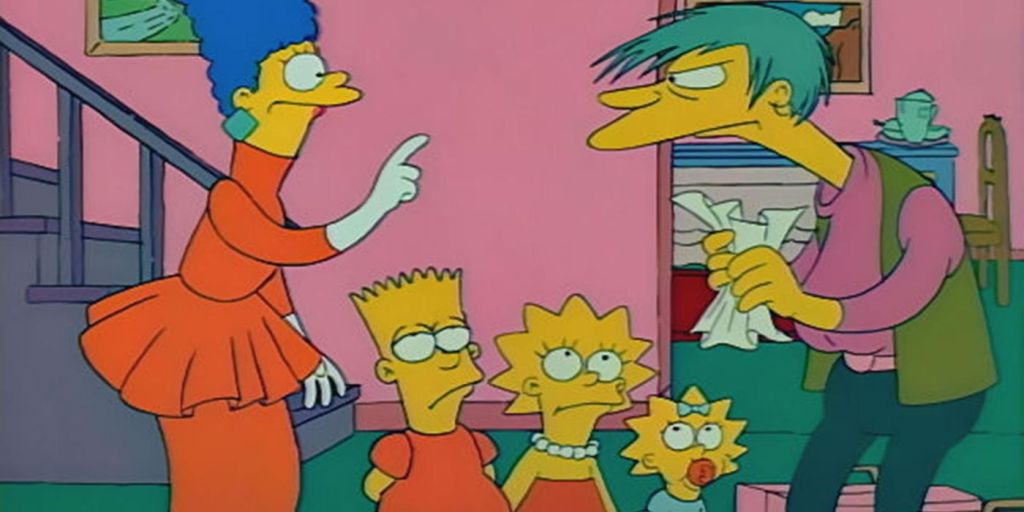
7. Some Enchanted Evening
Season 1 Episode 13 – May 13, 1990
Written by Matt Groening and Sam Simon. Directed by David Silverman and Kent Butterworth.
“Bart,” coos Penny Marshall’s Lucille “The Notorious Babysitter Bandit” Botzcowski, keeping watch of the Simpson children while Marge and Homer enjoy a well-earned erotic vacation from the family. “Time to brush your teeth, wash your face… and say your prayers.” This line encapsulates the evil Miss Botz, as all innocence drains into nightmarish danger. It is a perfect example of how inflection can command any line into lethal comedy.
“Some Enchanted Evening” was initially intended as The Simpsons’ pilot episode, but the animation was deemed so abominable, the producers almost canceled the show entirely. Only about a third of the original footage was used for broadcast, but it is this very raw quality which makes the installment so special. Marge starts proceedings by complaining about her unappreciative husband to radio psychologist Marvin Monroe during morning drivetime.
“Don’t say my name, don’t say my name,” Homer pleads before it all comes spilling out, in front of everyone at the nuclear plant. The dysfunctional family is perfectly laid out, from Homer’s less than spectacular job performance, to Marge’s rising resentment, and Bart, Lisa, and Maggie’s coping mechanisms. It may be crudely rendered, in the visual sense, but the storytelling and wit is concise, cutting, and unrelenting. Ending the first season rather than jumpstarting it, The Simpsons proves to be the perfect antidote to the family sitcom. But it didn’t solve problems with babysitters.
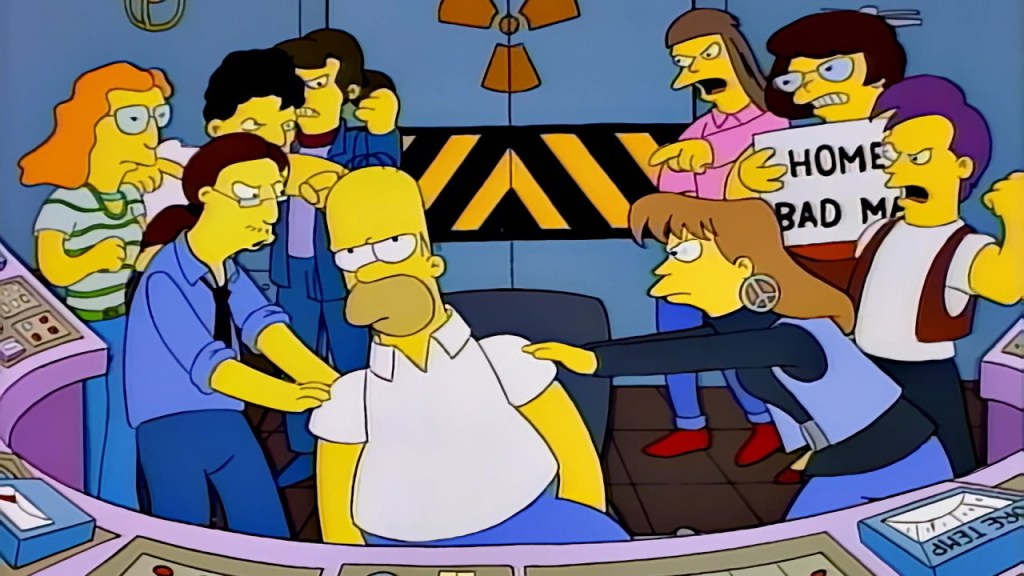
6. Homer Badman
Season 6 Episode 9 – Nov. 27, 1994
Written by Greg Daniels. Directed by Jeffrey Lynch.
When “Homer Badman” first aired, The Simpsons intended to take on the frenzied media of media frenzies and the tabloids which feed them. The episode was incisive at the time, and prescient of times to come. The targets are sexual harassment and trial by media, but its relevance grows in the wake of the #MeToo movement and the relentless backlash of public scrutiny. In this particular case, Homer is mistakenly accused, but Bart and Lisa’s discussions of feminism and misogyny are no accident. Homer’s intuitive initial solution, to move under the sea, is both a perfect reaction to a family crisis, and an excuse for a classic Disney parody.
It all begins with the “Gummi Venus de Milo,” a treasure stolen from a candy convention during a masterfully maneuvered heist, complete with extra pockets, and a Coke-and-Pop Rocks bomb. After a genius crime like that, it seems a shame to be condemned for a much stupider mistake. The stolen delicacy gets caught on the pants of babysitter Ashley Grant, a feminist graduate student who believes she’s “been given a crash course in depravity,” as a Hard Copy spoof show calls it, and is teaching a valuable lesson.
“2-4-6-8, Homer’s crime was very great,” protesters shout in front of the Simpson doorstep, and soon Moe, Barney, Lenny, Apu and Dr. Hibbert are taking bids on the juiciest gossip. It all culminates on the tabloid TV news show “Rock Bottom,” which convicts Homer through creative editing, and a TV movie starring Dennis Franz called “Homer S: Portrait of An Ass-Grabber.” The ordeal causes the family to fear television itself, something which has been “teacher, mother, secret lover” to them. To be fair to the accuser, she had a case when Homer asked her to take the wheel so he could scratch himself in two different places.
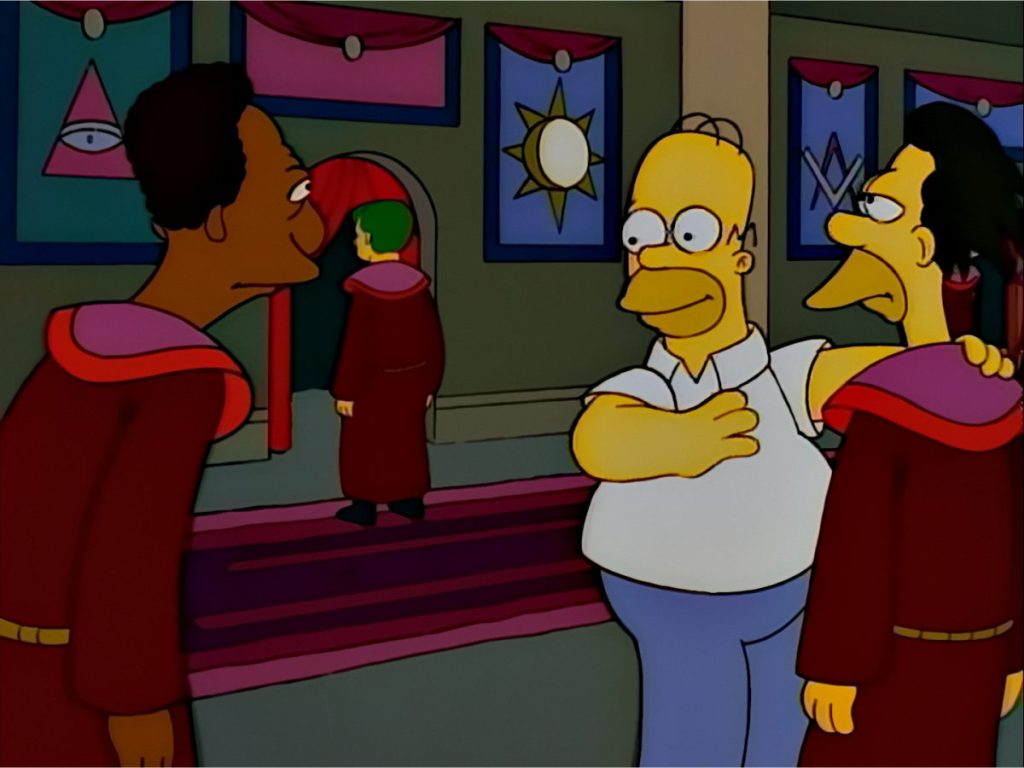
5. Homer the Great
Season 6 Episode 12 – Jan. 8, 1995
Written by John Swartzwelder. Directed by Jim Reardon.
“Freemasons run the country,” Mr. Burns hallucinated in season 5’s “$pringfield (Or, How I Learned to Stop Worrying and Love Legalized Gambling).” One year later, viewers learn what Burnsie was alluding to. Everyone knew, except Homer, who hasn’t been in the loop since elementary school when Homer Glumplich took the only exempted spot in the No Homers Club.
Homer stumbles over the classified information from Lenny: there is a secret society called the Stonecutters which yield unimaginable power in the world. They keep the Martians under wraps, hold back the electric car, and have the audacity to make Steve Guttenberg a star, as they sing in their secret fraternal fight song, “We Do.” Their claim to rig the Oscars may have some validity, the song was nominated for an Emmy. But don’t tell Homer. Everyone in Springfield belongs to the Stonecutters and enjoy all the perks, except him.
Even Abe Simpson is a member, as well being “an Elk, a Mason, a Communist, I’m the president of the Gay and Lesbian Alliance for some reason.” Patrick Stewart voices Number One, who heads the Springfield Stonecutter chapter. The hierarchy of the cabal is based on seniority, and for once, Mr. Burns is not the oldest chip in the block. Lenny and Carl get to boss him around in between drinks, ribs, ping pong, and paddlings.
“I always wondered if there was a god,” Homer tells his family. “And now I know there is. And it’s me.” The Three Stooges had a leader, Moe, who had a Beatles haircut before Beatlemania. Homer has a birthmark and it brands him the “Chosen One.” Uncovered after the newly inducted member defiles the sacred scrolls, Homer gets to replace his rock of shame with one of triumph, and it weighs heavy on him. Once declared leader, he becomes the most benevolent dictator, forcing his brethren to help the community until they have no choice but to form the Ancient Mystic Society of No Homers.
“Homer The Great” is the mother of all conspiracy theories, that’s why there has never been a follow-up and it has never been mentioned on the series again.
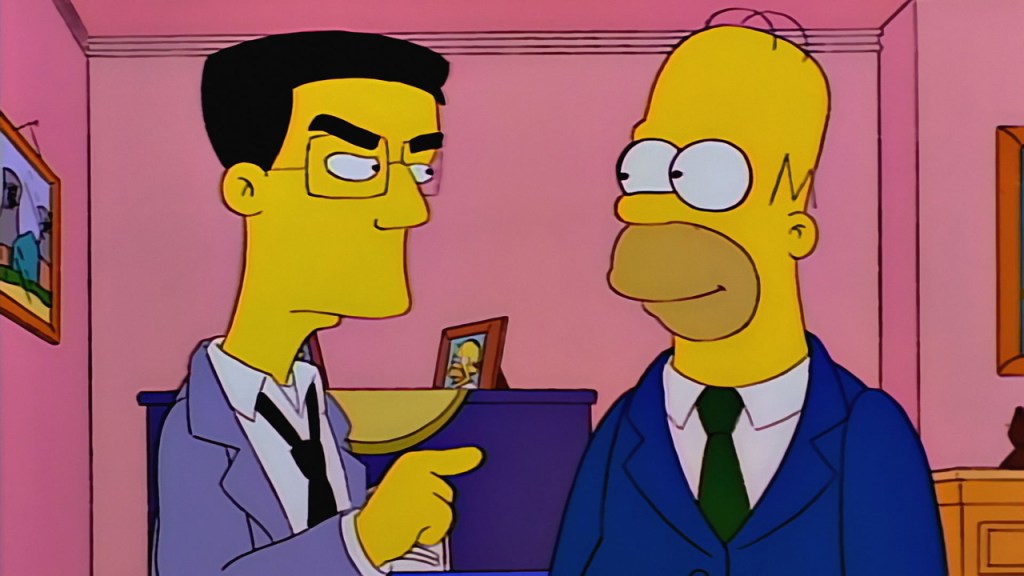
4. Homer’s Enemy
Season 8 Episode 23 – May 4, 1997
Written by John Swartzwelder. Directed by Jim Reardon.
“Homer’s Enemy” is one of the darkest episodes of situation comedy ever aired on television. It is also one of the funniest. Newly hired at Mr. Burns’ Nuclear Plant, Frank Grimes was abandoned at age four and blown up in a silo accident at 18, ultimately teaching himself to hear and feel pain again, and learning nuclear physics along the way. He had to work hard every day of his life, and what does he have to show for it? “This briefcase and this haircut,” he tells Homer after meeting his perfect family, in their castle of a home, compared to his apartment below a bowling alley and above another bowling alley. Homer’s life of sloth and ineptitude has gotten him everything, from presidential meetings to a trip to outer space, ever been? Wanna see his Grammy?
Hired as senior vice president, but stuck as a grunt in Sector 7G, Grimes sees Homer for what he is: What is wrong with America. “You coast through life doing as little as possible, leaching off decent hard-working people,” he explains. “If you lived in any other country in the world, you’d have starved to death long ago.” Grimey, as Homer calls him, declares war on his co-worker. The battle pits reality against The Simpsons’ reality, a self-starting scrapper versus an idiot who fixes warning alerts by watering down his workstation. It is a war of wits on a half-wit’s turf, and The Simpsons pushes its Homer advantage, with witty effect.
The secondary story is about Bart buying an abandoned factory and putting Milhouse to work keeping an eye on the place, which he does diligently, reporting “First it started falling over, then it fell over.” While some see “Homer’s Enemy” as an early indicator of their fall from grace, it is also a graceless fall into brilliance. Transparently cynical rather than subversively clever, “Homer’s Enemy” is hysterical, and when Grimes follows suit, the joke is on him, and Homer still gets the last laugh.
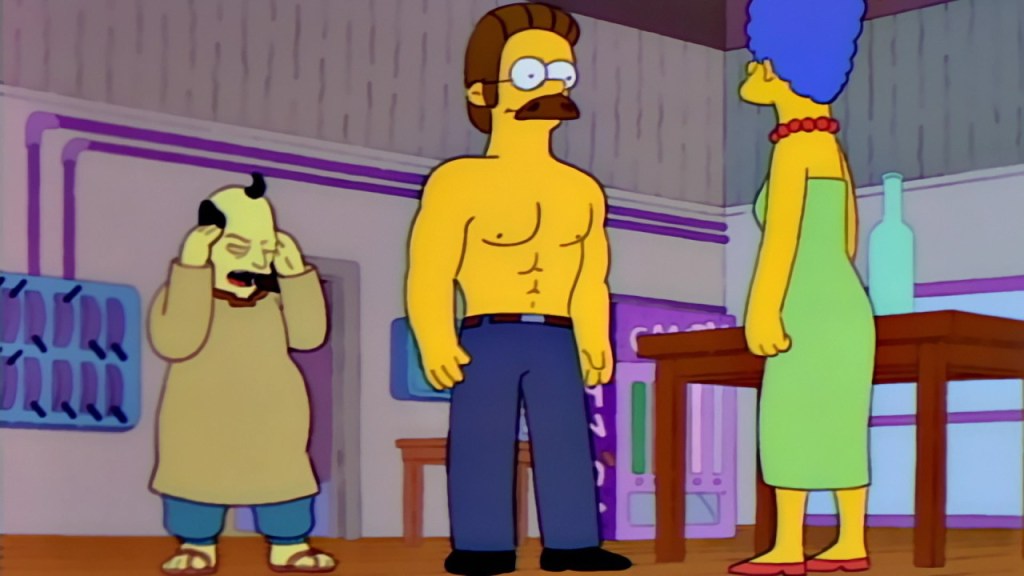
3. A Streetcar Named Marge
Season 4 Episode 2 – Oct. 1, 1992
Written by Jeff Martin. Directed by Rich Moore.
“Oh Streetcar!” only played one night at the Springfield Community Center, but its cultural impact on the town is immeasurable. 5, 6, 7, 8 … “A Streetcar Named Marge” opens by eviscerating beauty pageants to the tune of Janis Ian’s “At Seventeen.” It is not the only sonic reversal. Every one of the songs are ironic wonders, turning everything about Tennessee Williams’ Streetcar Named Desire on its head, flipping the ending into a brilliant twist of misplaced optimism, while maintaining all the emotional weight of the behind-the-scenes circumstances it reflects.
And the performances? Marge absolutely becomes Blanche DuBois in “A Streetcar Named Marge.” Homer is a stay-at-home Stanley. Besides the jokes and concept, the episode is dense with sight gags. While Marge is at rehearsals, Maggie is kept at The Ayn Rand School for Tots daycare center, an ominous pillar of learning which teaches such lessons as “Helping is Futile,” and doles out goodies from “The Fountainhead Diet” for lunch. “A is A,” they say in Atlas Shrugged. The scene where the family retrieves Maggie is an homage to the film The Birds, and contains one of the Alfred Hitchcock-patented cameos.
The biggest cameo isn’t Jon Lovitz’s guest-starring role as the production’s auteur director Llewellyn Sinclair, but Ned Flanders’ physique. He is ripped. After reaching an epiphany while singing the line “I’ll twist this bottle in your face,” Marge realizes how much she resents Homer. Marge breaks society’s notions of wifely duties, pursues her passion, but goes back to the status quo after Homer has a true epiphany of his own.
The opening song of the “Oh Streetcar!” gained its own controversy. It is a parody of the opening of Sweeney Todd, and describes New Orleans as a “city that the damned call home.” Populated by “pirates, drunks and whores,” it is a terrain of “tacky souvenir stores,” with no redemption in sight. A New Orleans newspaper critic published lyrics before the episode aired, TV stations received complaints, and radio stations broadcast protests. Bart would make a public apology on the chalkboard opening of “Homer the Heretic.”
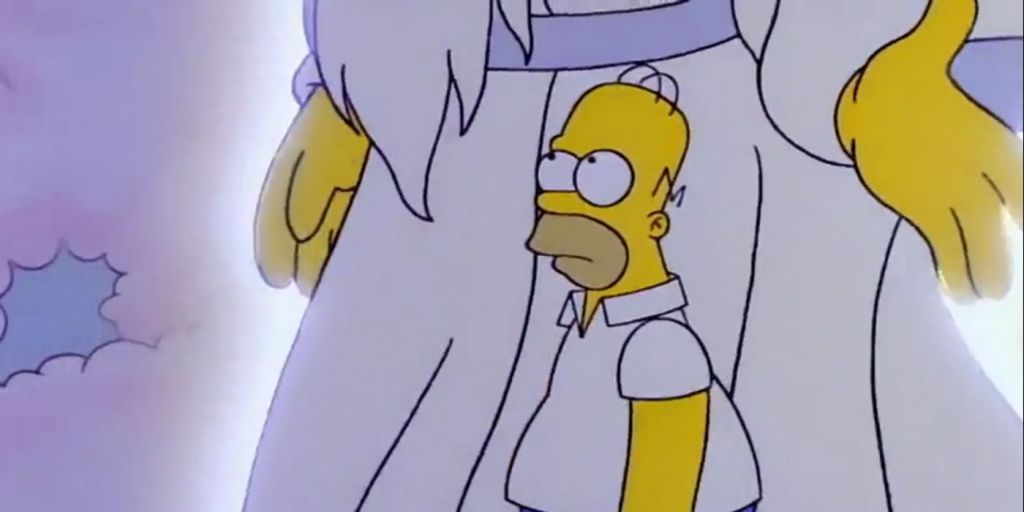
2. Homer the Heretic
Season 4 Episode 3 – Oct. 8, 1992
Written by George Meyer. Directed by Jim Reardon.
Split pants are the catalyst to inner peace in “Homer the Heretic,” which weighs the differences between faith, religion, sleeping in, and really buttery “moon waffles.” Homer owes the greatest day in his life to skipping church, and is determined to live up to the ideals of a non-denominational doctrine of his own design.
Ever since unborn-Homer was ripped kicking and screaming from his mother’s womb, he has been seeking its comfort and security. He only goes to church out of obligation to Marge, and let’s face it, Reverend Lovejoy makes the flames of Hell look like a tropical paradise compared to the snowbound house of worship with the frozen doors. By skipping church, Homer can turn the thermostat up to 100 and languish like a “big toasty cinnamon bun.”
Marge is shaken at being forced to choose between her god and Homer, the very idea of it tests the Simpson marriage. “Isn’t God everywhere,” Homer asks her. “And don’t you think the almighty has better things to worry about than where one little guy spends one measly hour of his week? And what if we pick the wrong religion? Every week we’re just making God madder and madder.”
In a dream, Homer encounters God, who has “Perfect teeth. A nice smell. A class act all the way.” God has five fingers, an extravagance the regular characters could not afford. They are drawn with four fingers to save labor. Heaven is a wonderland where Jimi Hendrix wails over Benjamin Franklin at air hockey. None of this means anything to Moe, of course. He “was born a snake handler and will die a snake handler.”
“Homer The Heretic” is a funny, profound, and insightful comic masterpiece. Homer actually does show real spiritual growth once he strips his guilt down to his “Short Shorts.” His newfound faith initially allows him to casually dismiss all others, offering a peanut to Apu Nahasapeemapetilon’s shrine to the Hindu deity Ganesha, snubbing Krusty’s Jewish Clown donation request on the grounds it is more religious than clownish, and outmaneuvering the entire Flanders clan rather than repent a single stolen moment of irreverent bliss.
These same people will save Homer’s life. Reverend Lovejoy is actually useful, and doesn’t negate Homer’s initial revelations. The fire on Evergreen Terrace is not the act of karmic wrath, but God was “working in the hearts of your neighbors when they came to your aid, be they Christian, Jew, or miscellaneous.” While this relegates 750 million Hindus to also-ran status, it also allows Homer to see some of the errors of his way. Recalculations ultimately reveal he can also sleep in church. After all, as he tells Lisa, “If I’m wrong, I can recant on my deathbed.”
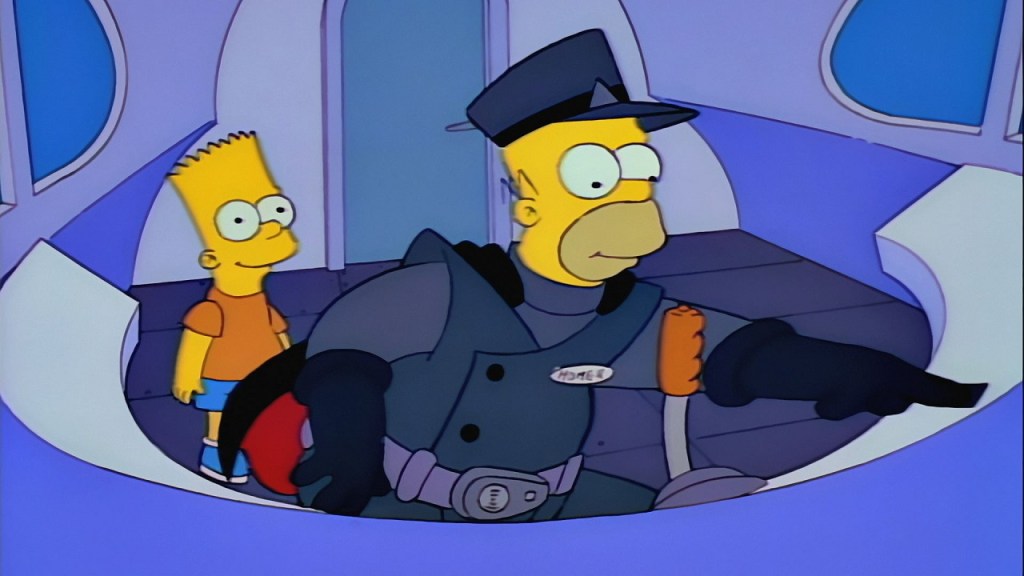
1. Marge vs. the Monorail
Season 4 Episode 12 – January 14, 1993
Written by Conan O’Brien. Directed by Rich Moore.
“Marge vs. The Monorail” may very well be the most perfect episode in The Simpsons repertoire. It’s got everything: songs, parodies, satire, social, political, economic, and environmental commentary, and the legendary Leonard Nimoy. Do you even know who he is? The Force is really with this one. It all begins when the EPA fines Mr. Burns $3 million for polluting Springfield’s parks, and the town rallies together to spend it. Marge makes a pitch for street repairs but is drowned out by a rivaling rallying cry.
A traveling salesman named Lyle Lanley, voiced magnificently by Phil Hartman, sells the town on the concept of a monorail, with all the razzle and dazzle of Robert Preston’s charismatic flim-flam marching band recruiter from The Music Man. “The Monorail Song,” written by O’Brien and Al Jean, is a major highlight of the series. Like the redundant and dangerous transportation system itself, the episode is a fast-paced, gag-heavy, joke-filled rollercoaster of an episode that only slows down once, for a haircut.
Marge is at the center of the episode, the only person in town, besides Lisa, who is worried about the monorail’s safety. Lisa isn’t fooled by Lanley’s trickery, but sidetracked by his flattery. Marge’s story runs on a different track than the rest of the story, but ultimately will derail the whole plan. The main plot sees Springfield catch monorail-mania, and bequeath Homer with the daunting honor of being the first conductor. He even gets a hat, but no brakes. They may have been in the advertising, but not part of the engineering plans.
“Marge vs. The Monorail” also features amazing highlights for supporting characters Chief Wiggum, Apu, Mayor Quimby, Moe, Lenny, Carl, Ralph, Patty, and Selma. The town really pulls together, while Marge tries to stop it from being ripped apart. Besides being one of the funniest episodes, it is also one of the most touching. Not only because of Marge’s desperation to save Homer from a calamitous end, even after their disparate reactions to the monorail, but also for Bart being seen as who he is by his father, a man he has a grudging respect for. With impending doom on the next turn, Homer realizes Bart is not an anchor, and tosses the M from Monorail into the giant donut to save the day.
Groening said “Marge vs. The Monorail” contributed to the decline in funding for real monorails.
Stay tuned for more lists of the best Simpsons episodes of each decade.
